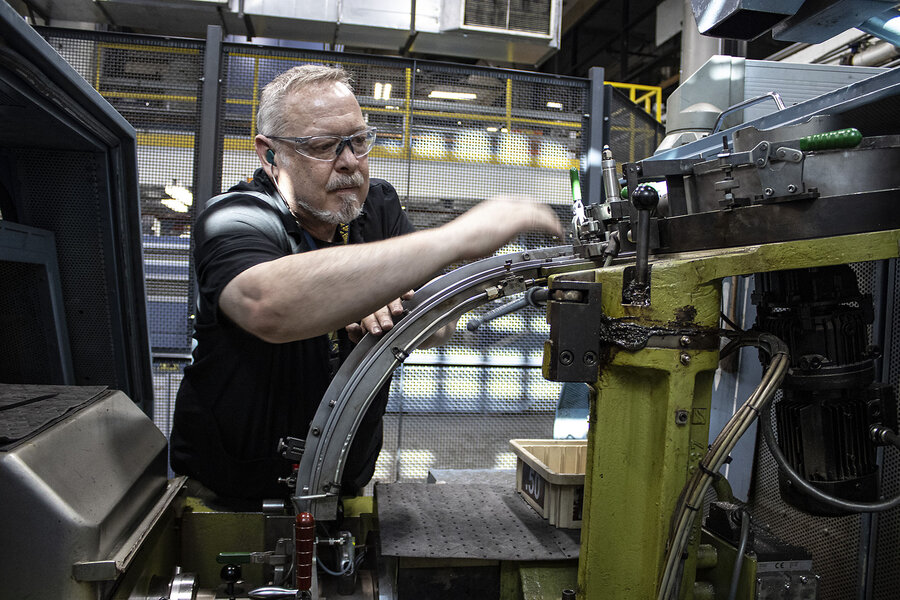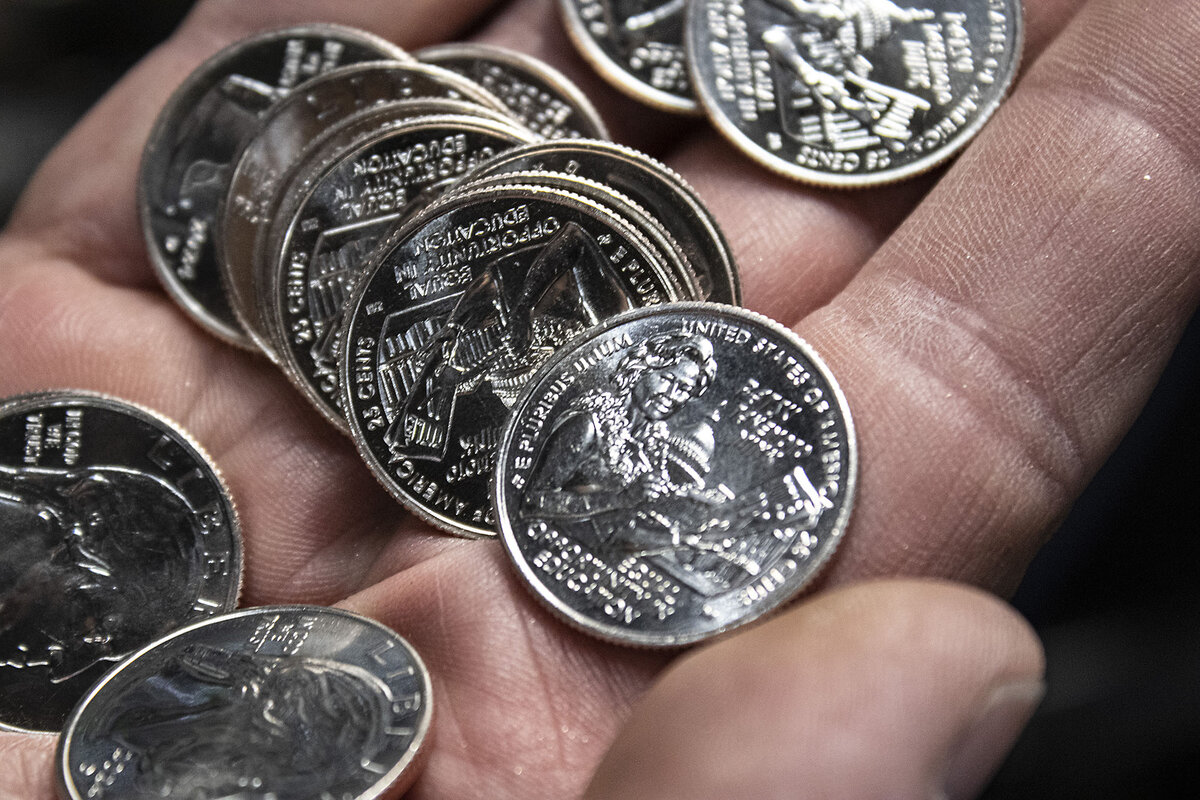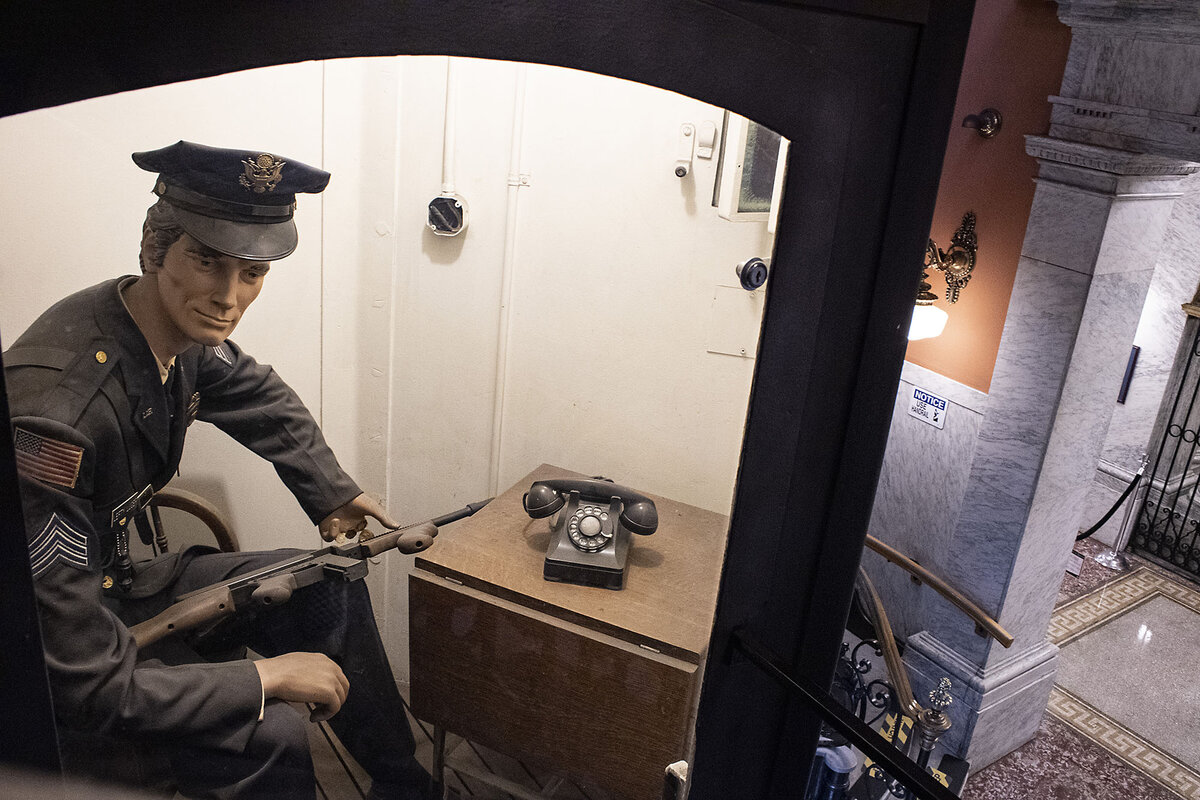As money moves digital, Denver Mint still coins a pretty penny
Loading...
| Denver
The furnace glows a toasty 1,314 degrees Fahrenheit. The silvery disks inside aren’t meant to melt, just soften, ahead of being stamped. That’s when they turn from a mix of metals into currency – in this case, quarters.
The U.S. Mint at Denver, on average, cranks out 10 million coins a day (roughly $1 million). Along with special collections, this mint in the Colorado capital produces circulating coins used in everyday transactions. Unless those pennies, nickels, and dimes hide in the creases of your couch.
Millions of Americans today, who can afford it, live far removed from cash. Many have filed their taxes due this week as pixels on screens. At the vanguard of this digitization of dollars is Colorado, with an annual blockchain conference and a governor who openly promotes cryptocurrency. Coloradans can even pay their state taxes that way.
Why We Wrote This
A story focused onThe U.S. Mint at Denver cranks out $1 million a day in coins. In an era when “frictionless” payment implies distance from human touch, there’s still value in having cash “in hand.’’
But here at the century-old Denver Mint, the physical legacy of money as well as its future for commerce and society are on display. For some people, physical currency is crucial for daily life.
In 2021, the “unbanked” share of the population stood at 4.5% of U.S. households – nearly 6 million, according to the Federal Deposit Insurance Corp. Eliminating cash would further shunt those people out of the economy, says Bill Maurer, director of the Institute for Money, Technology and Financial Inclusion at the University of California, Irvine.
For others, in an era when “frictionless” payment implies distance from human touch, there’s comfort in something you can hold in your hands.
After all, coins are “history in your pocket,” says Tom Fesing, chief of public affairs at the Denver Mint.
He scoops up quarters to pour into my palm. They glint, still warm, like stones left in the sun.
A golden beginning
Established by Congress in the 1860s, the first federal mint in Denver tested the gold brought in by eager miners. Today’s boxy building downtown, in operation since 1906, is modeled on the Medici Riccardi palace of Renaissance Italy. Flanking the granite exterior is a spiked wrought-iron fence. Nearly a fifth of the country’s gold reserves sit inside, Mr. Fesing says.
A brisk-paced former tour guide, Mr. Fesing leads me beyond the arched salmon ceilings of the grand hallway, part of a route that the public can visit for free. We gather eye, foot, and ear protection for the production floor, which jangles and clangs like a metal hailstorm. During the pandemic, when consumers and their cash stayed home, the Denver Mint upped production from five to seven days a week to offset poor coin circulation.
Basically, circulating coins here begin as faceless “blanks.” Several steps later, a press stamps their heads and tails (at a swift 12.5 coins a second). Fulfilling monthly orders from the Federal Reserve, the mint sorts and ships money off to destinations generally west of the Mississippi River. The U.S. Mint at Philadelphia handles east of the Mississippi.
Coins aren’t without controversy. Though offset by more lucrative products, the unit costs of pennies and nickels continue to exceed their face value – 3 cents and 11.5 cents respectively, according to the U.S. Mint’s 2023 report. Some Americans, citing frustration over the cost and nuisance of the small coins, have called on the government to retire them.
Though their relevance is questioned, coins are “one of our most ancient technologies,” says Professor Maurer of the University of California, Irvine. “As a human invention, they’re a relatively successful one and a durable one.”
Largely unchanged since production began around 500 or 600 B.C.E., the rounded form of coins is considered especially tamper-resistant. Cash is key for national emergencies, he adds, and vital for U.S. households without easy access to banking.
Under Gov. Jared Polis, Colorado is minting history of its own with digital assets. Colorado has recently allowed the payment of state taxes with cryptocurrency. Cryptocurrency is a type of virtual currency whose security comes from encryption. (Colorado receives digital assets converted into dollars via PayPal.)
But adoption has been slow since the option began in September 2022. As of last week, the Colorado Department of Revenue estimates that state income taxes have been paid via cryptocurrency 28 times. The state receives more than 3 million income tax returns annually.
At least for now, humans are still relevant at the Denver Mint, even among its maze of pale blue machines. One coin manufacturer, Carl Morgan, spot-checks a quarter that debuted this year featuring Patsy Takemoto Mink, the first woman of color elected to Congress. A hand-held device seems to assure him that the lettering is well aligned.
Employees here, and visitors like me, are subject to a no-coins-in, no-coins-out policy, and pass through security entering and exiting the building. Mr. Morgan puts the safeguards into simple terms.
“Any other job,” he muses, “if you ran across a pile of money on the floor, that’d be a good day.”
For all its rules, the place also has its quirks. A throwback to an older age, a mannequin guards the grand hallway, smirking in a sentry box. In his lap lies a replica machine gun.
He’s called Lefty Luger, says Mr. Fesing. “Because he’s left-handed.”
A real live police officer reviews my photos before I get to leave. All the shots seem to pass muster; I’d obediently avoided surveillance cameras and vaults. Exiting security onto the sidewalk, I’m as cents-less as when I arrived.
I can’t shake the sensation of a fistful of penny blanks: the smooth scales of a fish.










